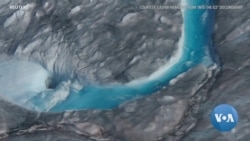The way we use land could be the key to adapting to climate change — or the final nail in the planet's coffin, according to a landmark climate assessment from the United Nations on Thursday.
Human use directly impacts 70 percent of the ice-free land on Earth, and we're degrading about a quarter of it, wrote the U.N.'s Intergovernmental Panel on Climate Change in the report.
"Land is both a source and a sink of greenhouse gases," says the 1,000 page document, which found that land has warmed twice as fast as the rest of the planet since the pre-industrial age. The warming is leading to more frequent and severe droughts in some areas and extreme precipitation in others, as well as more heat waves.
Those weather events, along with rising sea levels, thawing permafrost and more, are degrading our land and risking the food chains that billions of people rely on, the U.N. warned.
Cereal grain prices, for example, could increase by 7.6 percent by 2050, prompting the report to note, "The most vulnerable people will be more severely affected." Increased levels of carbon dioxide are also making plants less nutritious.
Plants, animals face changes
And as deserts and arid climate zones expand, coupled with shrinking polar climate zones, plants and animals "have experienced changes in their ranges, abundances and shifts in their seasonal activities," according to the report.
Scientists at a Thursday news conference on the report, however, emphasized that Earth isn't yet a lost cause.
"We don't want a message of despair," science panel official and Imperial College London professor Jim Skea told the Associated Press news agency. "We want to get across the message that every action makes a difference."
Solutions offered
The report offered a range of land-based solutions, including sustainable food production, better forest and soil management, more ecosystem conservation and land restoration, reduced deforestation and degradation, and reduced food loss and waste.
But humans need to be careful. Though a third of the food produced on Earth is wasted or lost, according to the report, solutions that compete with farming for land could worsen desertification and land degradation and risk people's food security. Irrigation can put salt in soil or deplete groundwater. When peatlands and other natural carbon reservoirs are disturbed by humans or extreme weather events, carbon dioxide accumulated over centuries can escape.
"There is a lack of knowledge" of the limits and side effects of adapting to climate change, the report acknowledged.
Action a must
But worse than taking action is doing nothing, scientists at the report's release Thursday said. Forests and other forms of natural carbon storage won't always be around, as business-friendly governments like those in Brazil capitalize on natural resources like timber from the Amazon Rainforest.
"This additional gift from nature is limited. It's not going to continue forever," said study co-author Louis Verchot, a scientist at the International Center for Tropical Agriculture in Colombia to the AP. "If we continue to degrade ecosystems, if we continue to convert natural ecosystems, we continue to deforest and we continued to destroy our soils, we're going to lose this natural subsidy."










